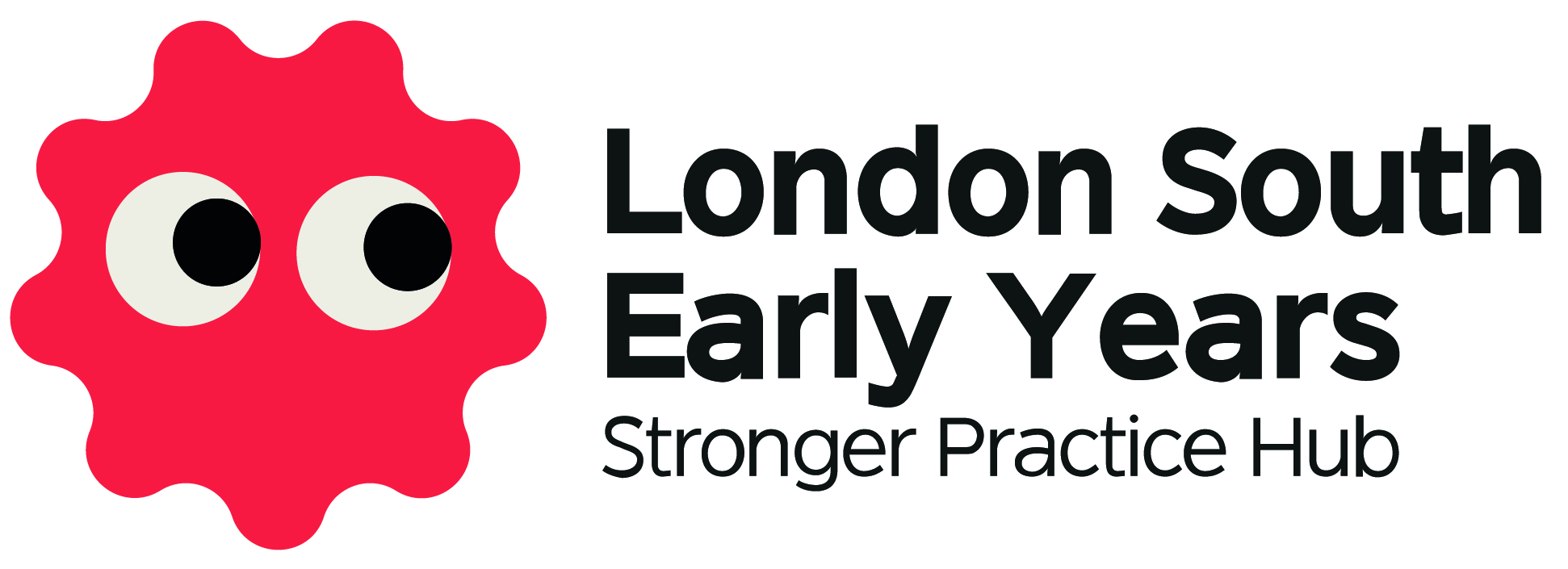During my time as a forest school leader at Charles Dickens Primary School and Nursery I was fortunate enough to be outdoors all year facilitating the learning of all our Early Years children from age two to five.
With the right clothing, being in the fresh air all year round is an absolute delight and a wonderful opportunity to connect with the children who prefer being outside and find ways to interest those who rarely venture outside. It is also an opportunity to refine practice, ensuring learning opportunities are well planned for just as much as they are for the indoor spaces.
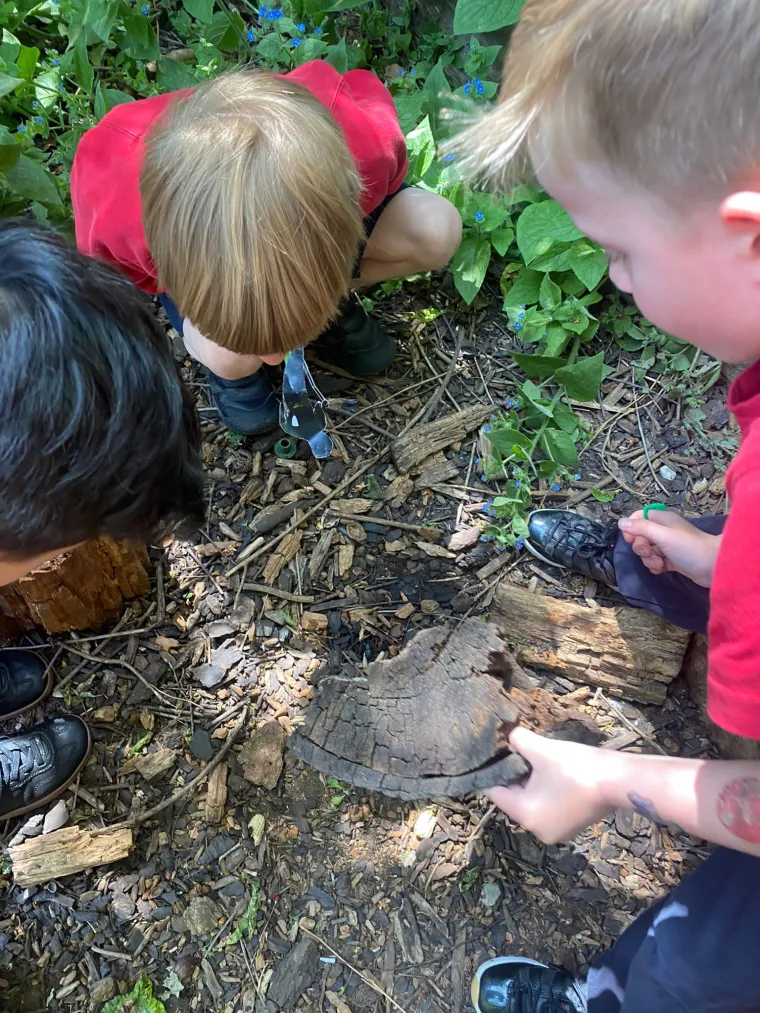
Here I shall share the opportunities for developing:
- Communication and Language
- Personal Social and Emotional Development
- Physical Development
A good starting point is to reflect on our own relationship with the outside and ensure we have the necessary subject knowledge to support children using the larger resources and space the outdoors has to offer. Outside should not be a space which is only used in fair weather with the same opportunities on offer as inside. Think big, plan for the development of the larger muscle groups, mark- making on a large scale, building with big materials and games that involve moving energetically. Our gardens also give us the opportunity to get up close to nature and develop an understanding of the changing seasons.
Be positive about being outdoors.
Have the right clothing for all weathers
Discover the deep interests of the children and build on those
Each session starts with the children coming together in a circle to get to know each other. A game will be played, the boundary will be agreed and an idea introduced. Each session will focus on the building of specific vocabulary and skills. Children choosing to participate in a different activity have vocabulary and skills introduced related to their interest- It is noted which vocabulary needs introducing to each child so gaps are filled accordingly.

The EEF has identified approaches supported by research that benefit communication and language. Find out more here, Early language | EEF (educationendowmentfoundation.org.uk)
The three approaches with the most evidence to support them are:
- Teaching and modelling language (rephrasing, echoing, adding)
- Teaching and modelling vocabulary (choose key vocabulary with intent)
- Interactive reading (focus on the children speaking- in the outdoor context this can be acting out known stories using the whole body)
These three approaches are supported by research as helping children make an average of 7 months added progress in Communication and Language. Outside, precise language related to large physical skills and safety needs to be planned for. Which words do you want the children to understand and be able to use? In relation to the natural world, ensure your curriculum incorporates the tress, bushes, plants, insects, and natural features present on your site or in your local community. Take account of the seasonal opportunities over the year being careful not to be confused by the misnamed terms. Spring term starts in the coldest part of winter! For seasonal ideas linked to language learning and interactive reading check out our resource,
Songs for our youngest learners can be found here.
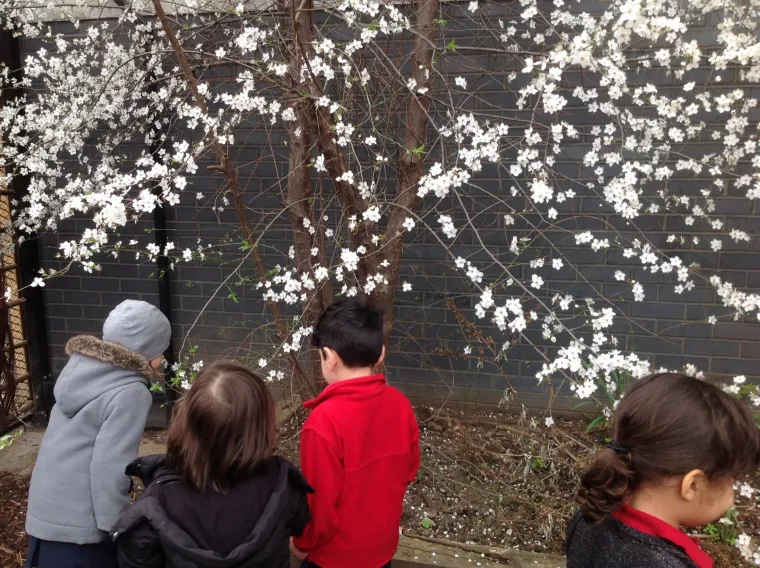
Non-academic research points to time spent in natural spaces as having a positive effect on wellbeing and physical development. Forest bathing is even prescribed by doctors to help ease the effects of mental illness. It makes sense for us educators to ensure children access the outside regularly to keep their mental health in check. Recent EEF guidance on self regulation and executive function has also highlighted two approaches, promoting physical activity and creating a community of collaborative learners that are supported by educational research. Learn more here, https://educationendowmentfoundation.org.uk/early-years-evidence-store/self-regulation-and-executive-function?approach=creating-a-community-of-collaborative-learners
Taking the forest school approach, of creating a community with the same small group of children, over a sustained period, in our case once a week for two terms, I was able to support children develop deep concentration, empathy, patience and a sense of calm. Outside lends itself to the building of large dens which usually requires a team effort. Such activities need quite a bit of planning, discussion around what can be used and where to find the resources so negotiation skills, flexibility and adaptation are all central to a successful outcome. Adults play a key role in asking the right questions at just the right time or even modelling the offer of a solution if the children are about to give up on the democratic process of negotiation. The aim is for the adult to not take over negotiations but rather, find ways to give an equal voice to participants and keep an eye on the need for some children to take the lead. Some children need to exhaust solitary play before recognising they need one other ally to be able to achieve more. A pair may then seek another helper when setting up a shelter, for example and therefore understand the value of working with more people.
A focus on Communication and Language
A typical Forest School session for us starts with a brief introduction with each child sharing how they are feeling that day. I sing and tap out the question with the children replying in rhythm whilst tapping their sticks. This is the time when the boundaries for the session are set, we recap the vocabulary learned the week before and briefly introduce new vocabulary related to a new skill or activity. Over the three terms the children became very aware of their natural surroundings and surprised us with the amount of plant vocabulary they retained. "Can I weed out the sycamore seedlings?", "This alkanet is spiky", "Where is the nasturtium?". A term in and the children were all displaying high levels of concentration and observation. Peer language included the taught vocabulary and expert negotiation. Listening to the conversations did make me very proud as language use had become very intentional and the levels of independence that came from that were satisfying to see.
Song, chants, gesture and real natural objects are used to introduce new vocabulary. That vocabulary is then regularly retrieved which helps make it stick. I also make links to the story books the children are exposed to. For example, we made all the homes mentioned in the Gruffalo using found objects in the Forest School, talking through each step, naming the materials and talking through how the home would be used.
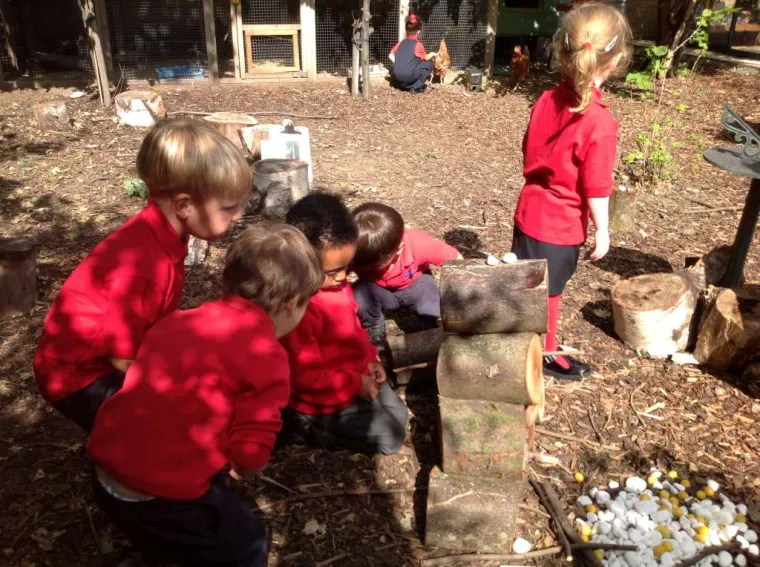
A focus on Personal Social and Emotional Development
As mentioned before, a big part of forest school is about building a community. This involves noticing where each participant is in terms of their self esteem, emotional development and social communication. The practitioner carefully builds the child from wherever their starting point is in a supportive, patient holistic way. Each group is very different as the individuals in each are so unique. Only once a group is respectful, harmonious and focused can we start to use tools or light a fire. Each tool is introduced very clearly with a tool talk that the children need to be able to recall. The children rise to the challenge and take great pride in using a tool safely and effectively. Tools are kept in a place of safety to be used occasionally to help children with their projects. Before fire lighting, the children participate in a fire safety session and learn how to make a fire without leaving a trace on the forest floor. Everything is very carefully considered, thinking and reflection slows down and the children are taken through each step thoroughly so the stages and safety at each stage are absorbed. At this point in the programme is when I experienced the children with concentration needs demonstrate the most focus. Children with impulsive behaviour became interested and measured at the mention of danger and challenge.
A focus on Physical Development
Outside there are ample opportunities to build on a large scale. Large logs are lifted and moved around to create habitats or works of art. Branches are propped up to make tepees and dens are made using the large tarpaulin. Lots of lifting, stretching and contortion is involved in putting large materials together to create new spaces. In a larger forest there are open spaces where running games can be played to get the heart rate up. On our small forest school site this is not possible so such games are carried out in a larger open playground. The manipulation of sticks, stones, leaves and other natural resources to make transient art and small world dens help develop hand-eye coordination. Simple knots are taught to the children ready for this skill so they can better carry out their plans.
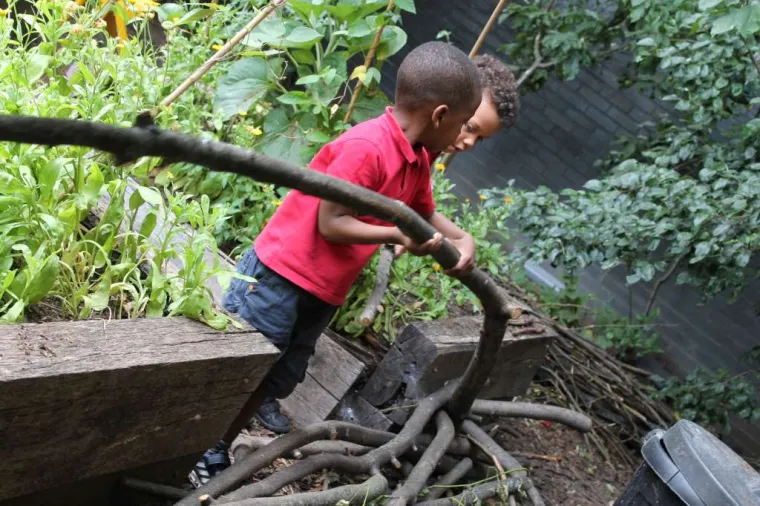
Main findings from the first term
In Autumn 1 children had varied experiences depending on their prior knowledge of natural environments. Some were scared, some in their element and others indifferent. By the end of the term all children became highly enthusiastic about attending sessions and passed on what they had learned to their peers and class teachers.
Children had the chance to work alone, in pairs or groups depending on how they felt at the time. Several children who found regulating their behaviour challenging initially became more able to self-risk assess and collaborate by the end of the term.
Some groups turned the session into a large problem solving activity involving almost all the children – their next step was to be able to do this without needing an adult to mediate. An example of this was the children wanting to transfer large amounts of water in a wheel barrow to water the newly planted trees using collected rain water tricky to get out of the low tap. How to then move the wheelbarrow without all getting soaked? The adult asked questions to guide the group- so the next step was- for the children to formulate these questions in the next problem solving situation.
All children developed their speaking skills over the term progressing in an accelerated way from their starting points. Those using single words progressed to using three word phases whilst those using simple sentences progressed to using more complex sentences. Children with no words were uttering some of the taught language by the end of the term.
Main findings from the second term
In Autumn 2 more risk was introduced in the form of fire as the children were showing signs of coping with boundaries and specific rules. They became familiar with the fire circle rules such as kneeling when close to the fire and using the outside of the circle to move to another place in the circle to avoid smoke. Children were taught the relationship between fire and water and the importance of having water close by. Children are not as aware of the sensation of damp wood. We collected wood a few weeks before making our fire to keep it in a dry place to allow the sticks to dry completely. Although the children experienced this, they still suggested making fire from newly found damp sticks shortly after it had been raining. Together we made a fire from damp sticks. It took ages to light and produced lots of thick smoke. This experience helped them understand the importance of firewood collection and preparation.
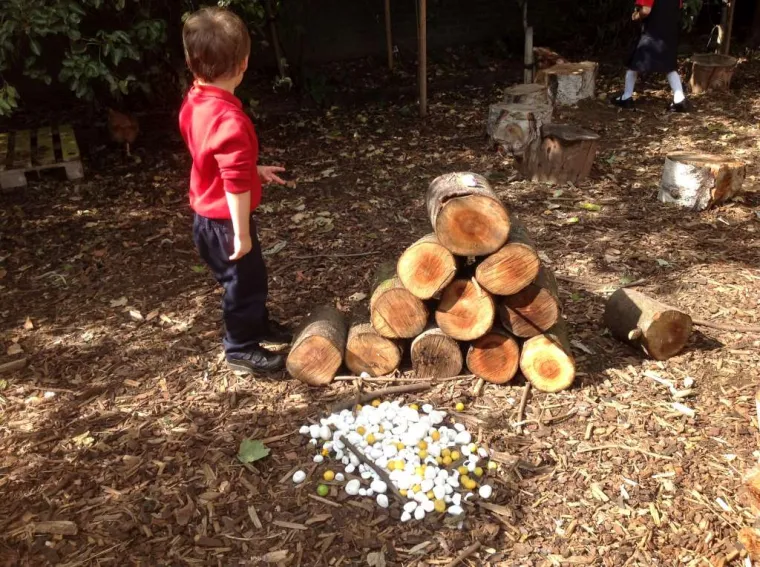
The children toasted bread on a fire using toasting forks. Only one child out of the 124 did not follow safety instructions and got a slight burn on his finger. All other children used gloves. We then added the step of putting our used forks into the water safety bucket. Children did well at adjusting around the fire safely to avoid smoke in the eyes, keeping a safe distance whilst cooking, using knives to spread the toast. Several children spread their toast with gloves on while it was still on the toasting fork only removing the toast once they had spread it. The next step here is to talk children through why we might choose to do things in a certain order. The children put safety first without considering the practical implications of the task.
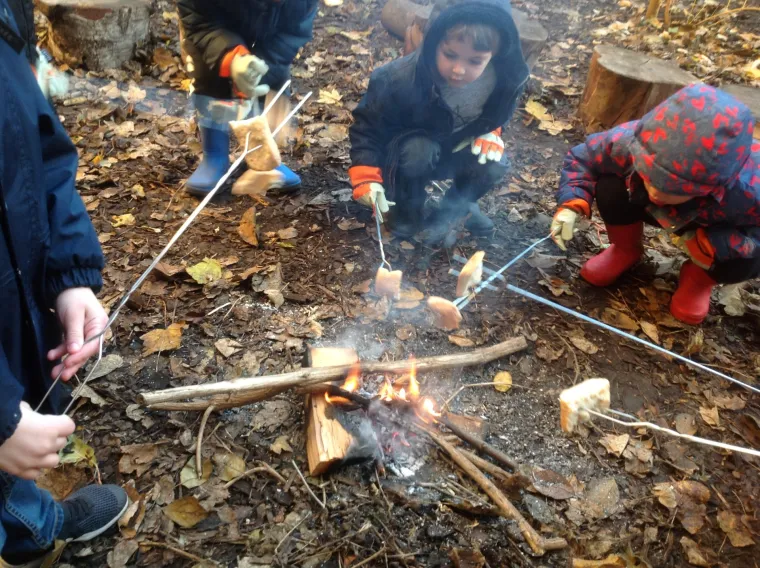
Den building also helped children understand the importance of forward planning. We made several tents experimenting with different heights and the use of extra poles and ground pegs. Children working alone soon realised this was a task best done enlisting the help of others.
All groups and especially the SEND group really enjoy looking for bugs. We have a good mixture of worms and the children can now see the difference between a composting worm and an earth worm. They were fascinated to see the various layers of the worm composter and amazed at the perfect black soil at the bottom of our hot bin. Under some of our logs there is a great collection of centipedes. The next step here is for children to understand bugs do not make great pets and should be returned to where they were found to not spoil the natural balance on our forest school site and to ensure we do our best to care for all living things.
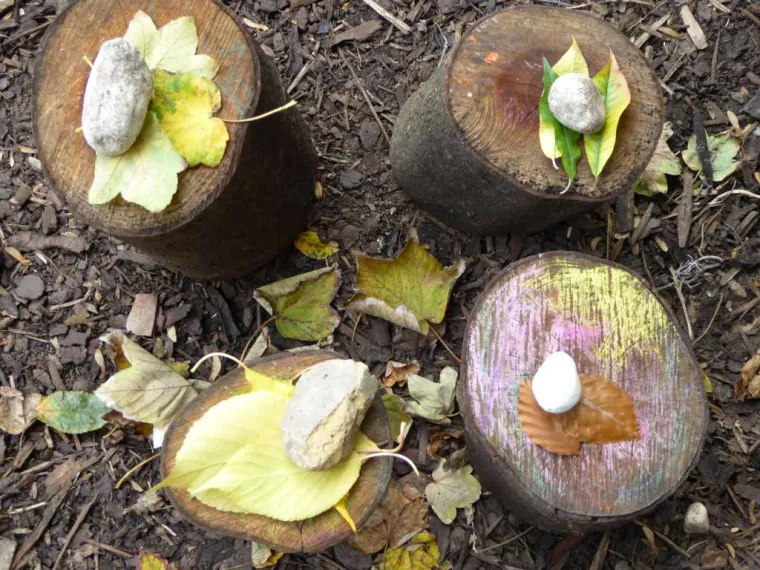
Children have ample time to complete their chosen activity, receive guidance on developing skills and language and just sit and wonder if that is what they need. There are also lots of opportunities for children to speak with each other and with me. At the start and end of the session children are invited to express their ideas, recall previous learning, ask questions and seek clarification. In addition some groups express a desire to talk around the circle so we have an extended circle time at the end or start of the session to allow children to have a chat often about home or weekend experiences they wish to share. One child starts and then others add often related material which then allows me to teach the art of conversation without the need to put hands up to speak. They learn to read the verbal and non-verbal signs during conversation so that all children have a chance to contribute. I hand the responsibility of being inclusive over to the group giving guidance when they appear to be struggling or when one child seems to be taking over without realising.
During this concentrated time exploring children's responses to being outside it was clear the children's interest in the environment encouraged all children to speak, make plans and collaborate. Our children with lower starting points in communication and language made significant progress and quality peer talk increased between children of all capabilities. The emphasis on planning carefully for language is consistent with the EEF approaches recommended for supporting communication and language development.
I'd recommend making use of your natural spaces to engage all learners and use the opportunities they provide for introducing, practicing and enjoying new and recently learned language. Outside really does seem to be a preferred learning space for many of our youngest learners so let's find ways to teach effectively in the outdoors.
